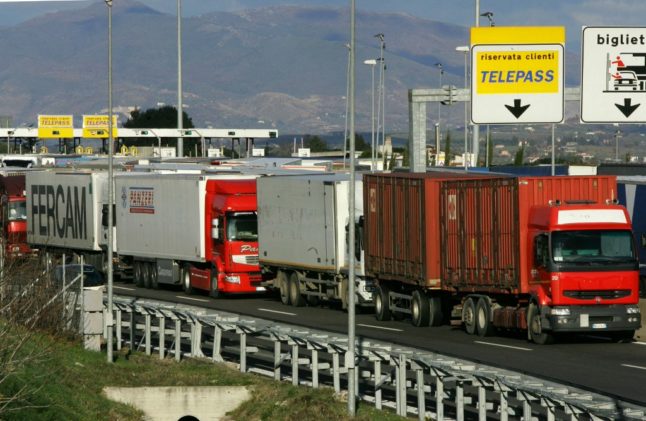A car is very often a necessity in Italy, where public transport can be scarce – whether you’re driving to work or visiting medieval hilltop villages.
And if you use Italy’s autostrade or motorways, you’ve no doubt heard about the Telepass system.
It’s not essential to have a Telepass, but it can be a convenient and cheaper way to use Italy’s motorways as well as to pay for parking, plus other transport services like taxis and trains too.
What is a Telepass?
Italy’s motorways are a network of toll roads. How much you pay depends on how much of the motorway you use, calculated by where you enter and exit.
You can take a ticket and pay when you exit the motorway, or you can use a Telepass.
The Telepass is best known as a device that you stick in your vehicle, which lets you pass through motorway tolls without queuing or the need to stop and pay with cash or card.
If you have the device, you can drive to dedicated lanes where the sign is displayed and you’ll see yellow lines and sometimes a yellow ‘T’ on the road. You can drive right through once you hear the beep on the device.
That sound means your entry or exit has been registered and the barrier will lift allowing you to pass through.
How do you get a Telepass?
You pay a monthly subscription for the device, starting from around €1 per month – although some plans offer the first six months for free, while the charges you incur while driving will be added to that fee.
Check the Telepass website here for details of current offers and pricing plans.
You can sign up via the website, or the app, through which you’ll also make payments and keep track of your subscription and expenses.
READ ALSO: How do you dispute a parking ticket in Italy?
Offers available via the app appear to require customers to provide a phone number registered in Italy, France, Germany, the US or the UK.
Once you sign up, the Telepass can be sent out to your home address. You can also choose to pick it up from a Telepass point, located at gas stations around Italy.
If you don’t want to pay monthly, for example if you’re just visiting Italy, there is a pay-as-you-go option too with a one-off activation charge of €10.
Where can you use a Telepass?
As well as for motorway access, you can also use the Telepass for various other things such paying for ferry tickets, parking, and congestion charges such as those in Milan’s ‘Area C’ traffic restricted area.
In car parks and on some street parking, you may see the Telepass function displayed in its usual blue and yellow signage.
If you see this sign, it means you can go towards the barrier, you’ll hear the beep and you can enter the car park. On exiting, the exact time you’ve spent there will be calculated and charged.

You may also see them at airports when you go to drop off or pick up passengers – and again, in some of their car parks too.
The same system applies, where your time will be automatically calculated and you can enter and exit without a ticket or paying at a machine.
If you have the Telepass app, you can also use it for everything from paying for car hire and train tickets to paying for fuel or bike sharing schemes.
For a full list of the services, in English, see here.
There is also a European version of the Telepass which can be used similarly in France, Spain and Portugal. There are plans to expand its use to additional European countries in future.
“The Europe device gives you access to the Autostrada in Europa service so you will be able to travel freely by car or motorcycle without barriers or borders,” the official website says.
You can sign up for this service for a €6 activation fee, with usage charged monthly. Find more details about it here.
Are there any alternatives to the Telepass?
The Telepass system has enjoyed its monopoly within Italy for more than 30 years, but just a few weeks ago a rival competitor launched a similar product – Unipol’s ‘UnipolMove’.
It replicates the Telepass function by means of a device – again, a type of small box that you put in your car or on a motorbike.
The UnipolMove allows automatic payment of motorway tolls through dedicated lanes and an ID system that communicates with the barrier, just like the Telepass.
READ ALSO: How visitors to Italy can avoid driving penalties
Paying for the device and charges are currently restricted to Italian IBAN numbers though, so the Telepass currently has wider appeal for international drivers.
Unipol’s packages aren’t yet as diverse as those of the Telepass, as you may expect. There is currently only one type of contract for the UnipolMove, whereas Telepass offers various packages.
The monthly fee is competitive at €1 per month, but at the moment it’s free for the first six months.
This new product also offers other services aside from motorway tolls, such as car parking and congestion charge functions.
For more details on the new UnipolMove, currently only in Italian, see here.
For more information on driving around Italy, visit our travel section for the latest updates.




 Please whitelist us to continue reading.
Please whitelist us to continue reading.
Should also mention the Via Card. It’s a prepaid card that can be used at the tolls and there are usually special lines. It’s not automatic like Telepass, but the lines are often shorter and quicker than the coin lanes. The Via Card lanes also accept regular credit cards, which I’ve use on occasion. You can buy Via Cards at Punto Blue offices that are usually located near entrances to the autostrada and at some tobacco shops.
More info here:
https://www.autostrade.it/it/il-pedaggio/viacard
Yet, if you want a truly Italian experience, use the coin gates during peak traffic time.
Good to know. Thanks Robby!